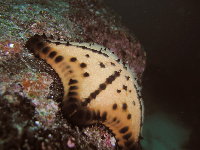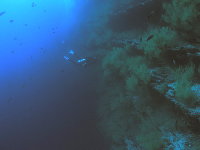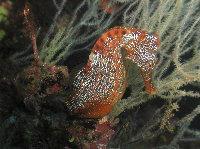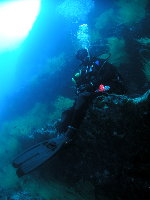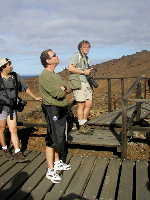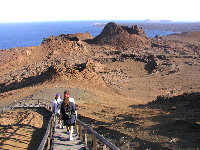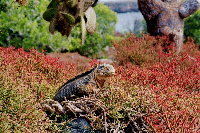|
After motoring
south through the night, we wake up to this view of beautiful Isabela Island.
The dark lines are lava flows. Three dives are planned here, as well as
some bird watching. Whaleman
is salivating over the prospect of bagging (with his camera) the flightless
comorant. It ends up being a weird looking bird with stubby wings, adapted
to flightlessness because of lack of natural predators. Darwin stuff. From
a bouncing rubber dinghy with a shutterlag digicam, I don't stand a chance
of getting a decent shot. |
|
For me, Isabela is all about starfish. They're fun
to shoot - they don't move, and they have weird and wacky colours and textures. |
|
I'm seeing stars here people.
So what if a few other people are seeing Manta Rays off the reef? I'm having
a fine time puttering along, taking sea star portraits... |
|
The aptly commonly named Chocolate Chip Sea Star. |
|
Manta Shmanta. Check out
the Smurf Star.
I'm going to make a true confession to you, dearest diary. I have been diving
solo here at Isabela. With good intentions we all start in a group. But
then some of us with cameras get all engrossed in the neat stuff on the
reef, while others want to go chasing elusive mantas, and before you know
it, you're all alone in the Pacific Ocean, just you and some darting seals
(who won't stop and pose for pictures, dammit), minimal current, a pony
bottle for a buddy, and your trusty dive flag to wave down the boat when
you surface. Solitude is pretty sweet in these conditions. |
|
It's day five already, and we are at Cousin's Rock.
Cris promises sea horses and sea lions and black coral and schooling fish.
We are not disappointed. |
|
That's deja doing
his video thang on the Cousin Rock wall. In amongst the bushes of black
coral (that are actually yellow) are seahorses and frogfish and all sorts
of neat stuff. It is here, on the first dive of three, that I have my only
major equipment fubar of the trip. I have neglected to check that my dump
valve is open on my drysuit before descending, and for a few bad moments,
I feel myself rising in an uncontrolled ascent like a helium balloon, while
I cling to the wall for dear life. Such relief to turn the valve and have
a huge fart of air come flying out of my sleeve. Oy, I've got such gas... |
|
Everything seems to grow bigger in the Galapagos. Even
the sea horses. |
|
This is a large
school of small barracuda. There is a point on Cousin's Rock where the current
splits, and it is here that there are large populations of fish, including
rays. Some of our group almost run out of air chasing down the rays at 100
ft, but my lips are sealed ;^) |
|
That's sapien taking
a breather on Cousin's Rock wall. The water is cooler here in the south
islands - about 68F, there is alot of current and you get pretty tuckered
after bagging three dives a day in those conditions. |
|
This dude greets us at the boat ramp where we are deposited
to explore the island of Bartolome. No fear is the motto of displaced California
sea lions that have found their way to the Galapagos, where they prosper
in large numbers. |
|
That's sapien,
whaleman and DrCraig contemplating the climb ahead. This is the first time
we've been ashore in five days, and the sea legs are complaining already.
To keep the islands as pristine as possible, all eco-tourists (that would
be us) must be guided, and not all islands allow people to touch down -
for instance going ashore at Wolf & Darwin is verboten. Paths are clearly
marked, and you are expected to stay on them. |
|
papa strikes a
pose in front of a beautiful backdrop.
|
|
What goes up, must
come down. There is no mistaking that these islands are volcanic in origin.
The islands were formed through a sliding plate over a hotspot, much like
the islands of Hawaii. |
|
Hullo. There's
a penguin on the telly (that's for the Monty Python fans out there). No
really. That is a penguin, and it is standing about as close to the equator
as it can. Just another strange animal anomoly in this group of remote islands.
We are given an opportunity to snorkel with the penguins, but unfortunately,
despite much patient floating around on our part, they decide it's too cold
to go swimming. |
|
Day 6. Man, it's early in the day for an excursion,
but we are heading to South Plaza Island on our last full day in the Galapagos
for a land
tour before we make one last dive at Gordon Rocks. |
|
That's an Aggessor
boat, with Gordon Rocks in the distance. This is a beautiful place - the
red
succulent plants and the gnarly cactus trees provide sensory overload,
as does the rather ripe aroma of sea lion guano... |
|
A sea lion sentry heralds our arrival on the island.
These guys are everywhere. We are literally stepping over them as we make
our way around the island on the circular path. One of them even clambers
out of the water to frisk
a few of us at the boat jetty. |
|
This iguana really
knows how to dress himself up for a party. There are also numerous marine
iguanas on the island, lounging on the rocks, soaking up the sun, after
forays into the sea to harvest algae. |
|
I'm ready for my close up
Mr. DeMille. It is unbelievable how unthreatened these sea lions appear.
To be able to walk right up to a wild animal and take a close up like this
almost defies imagination. |
|
The Galapagos Islands
are for the birds. This is a pair of mated swallow-tailed gulls. They have
a baby
too, and we get to watch them feed him. It actually is a bit gross - regurg
and all that. Deja manages to catch it on vid for all posterity. They are
distinctive red-eyed night hunting birds and I am going to look just like
them by the time I return home after a night flight out of Quito. |
|
Sadly this is the last dive
site of the trip, and we only get one dive here because we must fly home
tomorrow.
Gordon Rocks are the remnants of an ancient volcano caldera, and the ripping
currents through the underwater canyons attract big animals. But you are
just going to have to believe me when I tell you that we saw a school of
hammerheads and a squadron of rays fly through on our dive - my camera has
decided to take a well-earned vacation, and I am so tired after a week of
high-adrenaline, high-exertion diving that I can no longer see straight.
|
|
You can't see the forest
for the trees here at the Darwin Research Institute. This is where they
are breeding the ill-fated (and apparently delicious) Galapagos tortoises
that were eaten into extinction on several of the archipelago's islands
by various parties. There are minute genetic distinctions in the species,
specific to each island (there's that Darwin stuff again), so you can't
just plonk a survivor from one island onto another and hope to repopulate
it with the original species. |
|
Dude! Cris walks
us past the various pens where the tortoises are being raised before being
released back into the wild. These animals move slower than molasses in
January, and grow about as quickly. It takes many, many years for them to
reach full size and sexual maturity. |
|
I could live here, at least in my dreams. This is the
waterfront town of Porto Ayora, the antithesis of places like Playa del
Carmen and San Miguel in Mexico. Laid back, cheap eats, non-persistent vendors
and more dive operators per capita than can be good for a place that is
this charming. |
|
Charles Darwin
would be proud of these pelicans. They have figured out that the road
to survival is paved with tossed fish guts. All they have to do is show
up every day at the docks where the fishermen clean their catch.
Mine, Mine, Mine,
Mine, Mine...
|
Epilogue
This photo essay
may appear a bit irreverent, but I have no words that can adequately describe
the wild combination of awe and adrenaline that I experienced on this
trip, nor the right superlatives to convey the raw beauty of these incredible
islands. Still, even a couple of months after returning from the Galapagos,
I felt compelled to try to capture and share the experience through a
combination of pictures and text. And this photo essay is what resulted
from that need.
On a tragic note,
just a week or so after we returned from this trip, there was a news report
about an illegal fishing vessel that had been apprehended near beautiful
Isabela Island with at least 800 shark fins on board. As abundant and
as remote as the Galapagos may appear, they are a very fragile ecosystem,and
we should all be concerned with their protection and preservation.
The G spot reference
in the name of this trip report is a bit of an inside joke from the trip,
as well as an obvious play on words. DrCraig, who is a veterinarian, illuminated
us over beers our first night in Quito as to the intricacies and perils
of cattle insemination. I'll leave it to him to explain how exactly this
is achieved ;^)
The diving was
challenging - and I am told that the conditions for our week were pretty
tame, compared to what they can be in this part of the world. Cold water,
loads of current, variable visibility and large predatory animals in the
water all combine to make this kind of diving a little out there. I couldn't
recommend this trip to divers inexperienced in these kinds of conditions
(excepting interactions with big animals), nor to those who are not in
good physical condition.
braciole is the
man who put it all together. I can't thank him enough for his organization
and his enthusiasm, not to mention his tick tock countdown to Galapagos
e-mails.
I can highly
recommend the Galapagos Aggressor. It is a very nice boat with an obliging
and energetic crew. The Aggressor
website has very comprehensive information about the practical details
of the Galapagos itinerary - more than I could ever hope to cover in a
trip report.
D2D divers braciole,
contessa, deja, drcraig,
ga_seafan, hawn_diver, joe bennie,
papa, Rick, sapien,
scubadawg, twang, whaleman
- thanks so much for the laughs, the thrills and the memories. And thanks
too for the wonderful videos, slideshows and images you have shared. chrism,
you were missed, and as disappointed as I know you are that you had to
cancel out of this trip, I know there is a Galapagos adventure out there
waiting for you and your magic camera...
|

